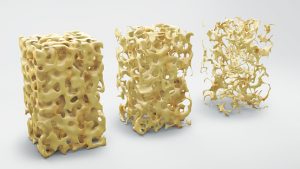 If you’re over the age of 50, then bone health is a serious concern—even more so if you’re a woman. When a person develops osteoporosis, their bones become weak and brittle, which increases the risk of fractures. Osteoporosis also negatively impacts mobility and can lead to isolation and depression.
If you’re over the age of 50, then bone health is a serious concern—even more so if you’re a woman. When a person develops osteoporosis, their bones become weak and brittle, which increases the risk of fractures. Osteoporosis also negatively impacts mobility and can lead to isolation and depression.
Osteoporosis is often called “the silent disease” because bone weakening is hard to detect and signs and symptoms can go unnoticed. It may not be until your doctor runs a routine bone scan that signs of osteoporosis are seen. When this occurs, it may be too late, as damage caused by osteoporosis is nonreversible. Early detection is key, so that treatment can take place and the degeneration of bones can be slowed down.
Advertisement
Below are five signs and symptoms that can be an early warning of weakening bones. By picking up on these signs and symptoms, you can have better success in slowing down osteoporosis progression and protecting your bones and overall health.
5 early signs and symptoms of osteoporosis
1. Muscle or joint pain: Growing older brings along muscle and joint pain, so this symptom is often easy to overlook. The difference between older-age joint and muscle pain and a symptom of osteoporosis is that this pain is constant and can even be quite severe.
2. Height loss: Bone diseases like osteoporosis affect the spine, which can cause it to collapse and result in loss of height. This is another symptom that is often overlooked, but if loss of height occurs rapidly, it should be taken quite seriously. Losing over three centimeters is a tell-tale sign of bone problems that should be medically examined.
3. Retreating gums: You may not think that your teeth and gums are related to bone loss, but they are. This is because our teeth are connected to our jaw; therefore, bone loss in the jaw can cause gums to recede, which leads to the loss of teeth. This is why it’s important to see a dentist regularly, as they can spot changes to your gums, teeth, and jaw before your doctor can.
4. Weakened grip: One test that doctors may use to detect bone loss is a balance-and-grip test. You can do this test on your own if you feel that you may be experiencing bone loss. Simply try and grip something—a door handle, water bottle, etc.—and if you notice your strength has weakened and your grip isn’t as strong, then you will want to see your doctor. In the meantime, it’s important that you perform specific exercises in order to build muscle strength and strengthen your bones. Weight-bearing and resistance exercises are best for this.
Advertisement
5. Easy fractures: If the most minor movement causes a fracture, then it is a very clear sign of osteoporosis, as you should not experience fractures from simple, everyday movements. If this does occur, seek medical attention right away.
Keeping an eye out for these early signs and symptoms of osteoporosis can reduce your risk of injury and progression of osteoporosis.
Related: Osteoporosis: Causes, symptoms, diagnostic tests, and how to treat
